Blechnum
Here is an interesting genus with representatives from all over the world. It includes several familiar species and over 160 not-so-familiar ones. I will not discuss some of the smaller and better known species here (the Gondwanic B. penna-marina, for example, does make a fantastic ground cover, adapting itself to many Northern Hemisphere gardens as long as the climate isn't too severe), just the ones which come closest to falling into the category of "cold-hardy tree ferns" or are otherwise of great interest.
All Blechnums, except the special crested forms, have simple fronds which are divided only once. With most species, the pinnae are fairly wide with little space in between, giving the fronds the appearance of large, coarse textured leaves. Although not quite on the same scale as many species of Dicksonia and Cyathea, and other large trunking treeferns, they are nevertheless magnificent and should be more widely grown. Most are very primitive looking in a slightly different manner than the more common tree ferns, superficially resembling cycads. All appreciate a moist loamy soil.
Blechnum brasiliense (South America) - This is one of the better known and more common species of Blechnum in warmer climates. It forms a small trunk. On some forms, the new fronds emerge a beautiful pinkish-red, making the fern very attractive. 27°F.
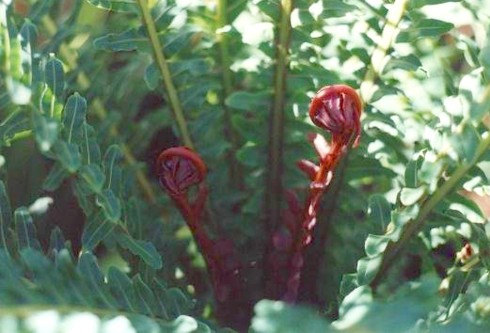
Blechnum brasiliense, red form, with new fronds emerging. Photo courtesy of Keith Rogers, Mannum, South Australia.
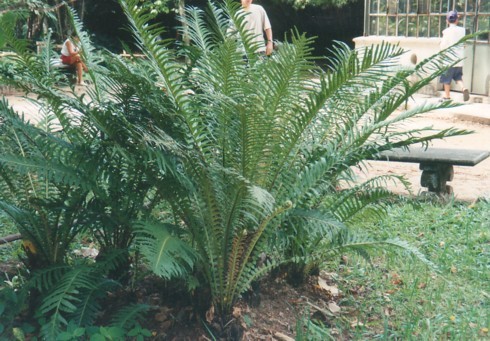
Blechnum brasiliense in Brazil. Photo courtesy of Ed Brown.
Blechnum chilense (Chile) - A large Blechnum which grows in damp areas in central and southern Chile, and adjacent parts of Argentina. It does not really form a trunk, but has underground rhizomes which spread and send up more crowns in the vicinity of the main plant. In this way it can colonize a large area over time. It tolerates sun if there is enough moisture, but reaches its full splendor in a shady moist cool setting. In such areas its fronds may reach 5' in length, and are a very attractive deep green color.
Blechnum cordatum (South Africa) - This species is very similar to B. chilense; in fact the two may eventually be classified under the same name. It is perhaps a smaller fern than B. chilense. More information forthcoming.

Blechnum cordatum, or possibly B. chilense, in a Seattle garden. Photo by the author.
Blechnum cycadifolium (Juan Fernandez Islands) - An interesting Blechnum, and one of many fascinating plants (including a few species of Dicksonia) from the Juan Fernandez Islands. It grows on steep hillsides and cliffs of volcanic rock, in the open, especially near the sea but up to 3,000' elevation. Its fronds have a very tough, leathery look and really do look like cycad leaves when they uncurl. Because the fronds are so tough and wind-tolerant, this may be a good Blechnum for less-than-ideal fern growing conditions. Like cycads, they also form stout trunks. One would think it is probably hardy to at least 20°F. Someone introduce this fern to cultivation, please!
Blechnum discolor (New Zealand) - An attractive Blechnum with very narrow fronds to about 3' long or slightly longer. Forms a trunk to 3' in sheltered situations. Easy in a moist sheltered site, but probably meets the limit of its hardiness around the upper teens F.
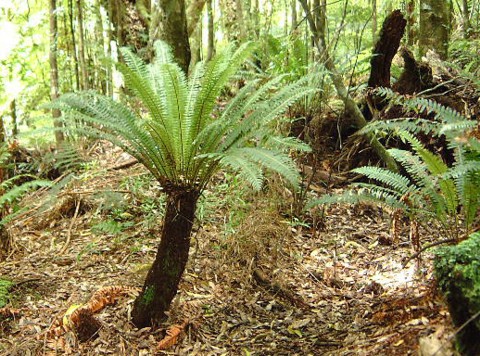
Blechnum discolor in habitat in New Zealand. Photo courtesy of Peter Richardson.
Blechnum fraseri (New Zealand etc.) - This is an interesting slender-trunked species from the North Island of New Zealand. It prefers to grow in drier, more open (but not too exposed) patches of forest, and spreads by underground rhizomes to form extensive colonies. The fronds are bipinnate, unusual for a Blechnum. Can be a bit tricky to accomodate in cultivation.

Blechnum fraseri in New Zealand, showing the twice-divided fronds. Photo courtesy of Peter Richardson.
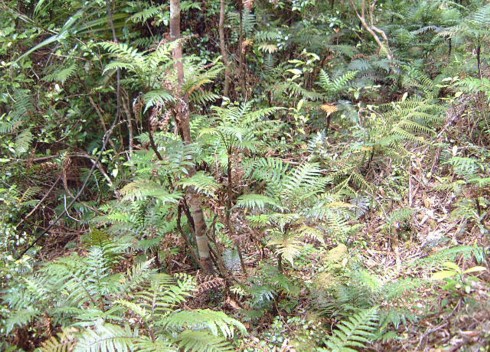
Colony of Blechnum fraseri. Photo courtesy of Peter Richardson.
Blechnum gibbum - Listed here because it is common and easy to grow in a warm climate. It quickly forms a small, slender trunk with numerous bright green fronds at the top. 27°F.
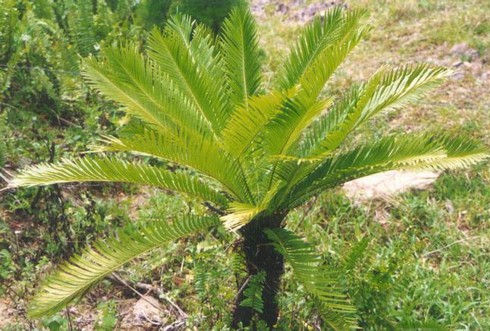
Blechnum gibbum. Photo courtesy of Peter Richardson.
Blechnum longicauda (Juan Fernandez Islands) - This extroardinary fern does not form a trunk, but has fronds up to 7' long (but only 8" wide) which have a "bud" at the tip where a new plant will start when the frond tip touches the ground - not unlike the mother fern, Asplenium bulbiferum. Sounds interesting.
Blechnum magellanicum (Chile) - Closely related to B. chilense, this species comes from extreme southern Chile and possibly Argentina in very wet and somewhat cold rainforest. It develops a very large, stout, dark trunk up to 5' tall (taller in sheltered gullies) and has a very impressive crown of many arching fronds which may exceed 6' long. Judging by its place of origin, it has to be hardy to at least about 12°F and perhaps a good bit lower. This is definitely one of the most fascinating Blechnums, looking very much like a Cycad but being much better adapted to a cool maritime climate. It has been grown in England, though it is very rare, and should be introduced to cultivation in the United States.
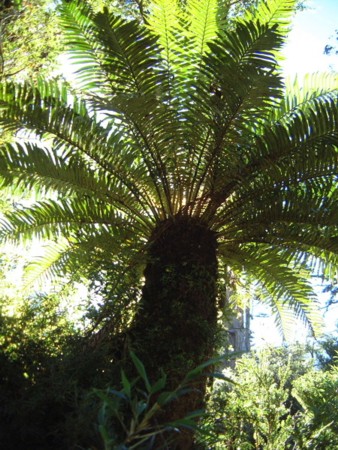
Blechnum magellanicum in habitat in Chile. Photo courtesy of Mark Morgan.
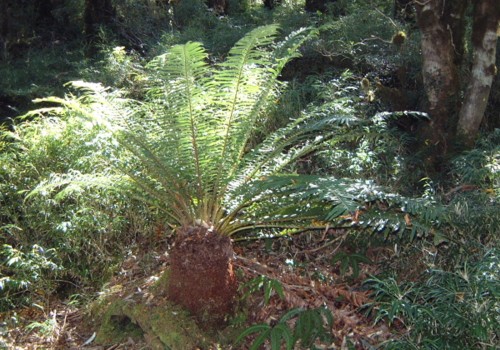
Blechnum magellanicum in habitat in Chile. Photo courtesy of Mark Morgan.
Blechnum nudum (Australia) - A large Blechnum that grows in woodlands and on streambanks in southeast Australia. It is probably hardy to about 16°F, or possibly lower, and the fronds may reach about 4' long. The plants may contain a large number of fronds at once. Although it really does not form any substantial trunk, it is a spectacular fern for gardens of tree fern enthusiasts.
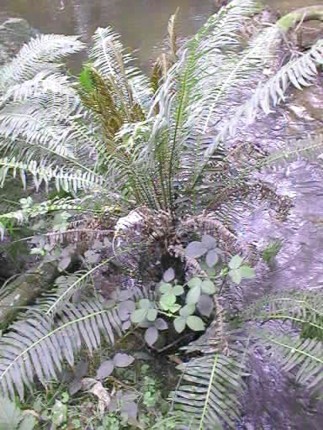
Blechnum nudum in habitat, Victoria, Australia. Photo courtesy of Scott Ridges.
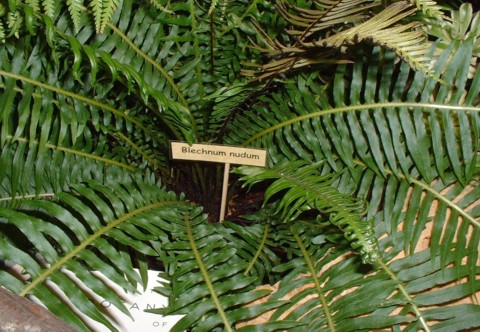
Blechnum nudum, close-up of plant at the 2002 Northwest Flower and Garden Show in Seattle, WA. Photo by the author.
Blechnum palmiforme (Gough Is., of the South African Coast) - This stout-trunked fern which grows in exposed places looks like nothing so much as a Cycas sp. The fronds are point upward at about a 30° angle from horizontal, atop a clean trunk which reaches about 5'. I have never heard that it is in cultivation.
Blechnum tabulare (South Africa) - A large, very impressive Blechnum coming from Table Mountain in South Africa. Although a tough plant that is able to withstand brush fires in habitat, it has the reputation for not being easy to grow. It also grows in fairly exposed places, where it is subject to wind, frost and snow, but it is probably not extremely cold-hardy (upper teens F might be a good guess). Sometimes the trunks may tend to collapse once they reach several feet high. It is becoming rare in the wild from overcollection.